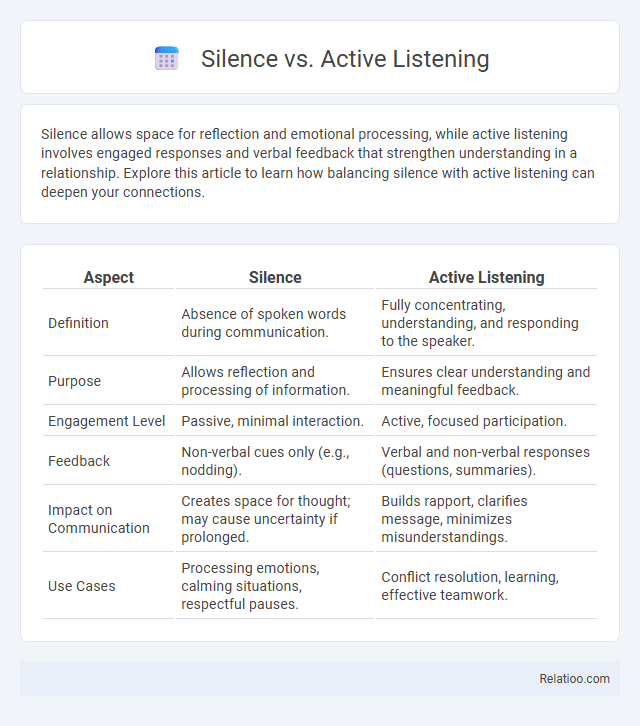Silence allows space for reflection and emotional processing, while active listening involves engaged responses and verbal feedback that strengthen understanding in a relationship. Explore this article to learn how balancing silence with active listening can deepen your connections.
Table of Comparison
| Aspect | Silence | Active Listening |
|---|---|---|
| Definition | Absence of spoken words during communication. | Fully concentrating, understanding, and responding to the speaker. |
| Purpose | Allows reflection and processing of information. | Ensures clear understanding and meaningful feedback. |
| Engagement Level | Passive, minimal interaction. | Active, focused participation. |
| Feedback | Non-verbal cues only (e.g., nodding). | Verbal and non-verbal responses (questions, summaries). |
| Impact on Communication | Creates space for thought; may cause uncertainty if prolonged. | Builds rapport, clarifies message, minimizes misunderstandings. |
| Use Cases | Processing emotions, calming situations, respectful pauses. | Conflict resolution, learning, effective teamwork. |
Understanding Silence: More Than Just Absence of Sound
Silence goes beyond simply the absence of sound; it serves as a powerful tool for active listening, allowing your mind to absorb and process emotions and information more deeply. Active listening involves intentional silence to give full attention, enabling empathetic understanding and meaningful communication. Recognizing silence as a dynamic space enhances your ability to connect and respond thoughtfully in conversations.
Defining Active Listening: Principles and Practices
Active listening involves fully concentrating, understanding, and responding thoughtfully to the speaker, enhancing communication effectiveness. Key principles include maintaining eye contact, providing feedback, and avoiding interruptions to ensure your message is accurately received and understood. Practicing active listening cultivates empathy and trust, setting it apart from mere silence or passive hearing.
Psychological Impact of Silence in Communication
Silence in communication can create a powerful psychological impact by allowing space for reflection and emotional processing, often fostering deeper understanding and trust. Active listening, which involves not just hearing but attentively responding, enhances connection and validates the speaker's feelings, strengthening interpersonal bonds. Your ability to balance silence with active listening can significantly improve communication effectiveness, reducing misunderstandings and promoting empathy in conversations.
The Role of Active Listening in Building Relationships
Active listening plays a crucial role in building relationships by demonstrating genuine attention and empathy, which fosters trust and understanding. Silence during conversations allows space for reflection and emotional processing, but active listening transforms silence into meaningful engagement by encouraging open communication. By practicing active listening, you enhance your ability to connect deeply with others, strengthening relational bonds and reducing misunderstandings.
Silence as a Tool: When and Why to Use It
Silence as a tool in communication allows your message to resonate, enabling deeper reflection and emotional processing during conversations. Active listening involves attentive engagement, yet purposeful silence creates space for understanding unspoken feelings and encourages openness. Knowing when to use silence enhances your communication effectiveness by fostering trust and allowing others to articulate thoughts without interruption.
Benefits of Active Listening Over Passive Hearing
Active listening enhances your understanding by fully engaging with the speaker's message, enabling deeper connections and more effective communication. Unlike passive hearing, which merely captures sounds, active listening promotes empathy, retention, and problem-solving. This focused attention reduces misunderstandings and fosters trust in both personal and professional relationships.
Common Misconceptions About Silence and Listening
Common misconceptions about silence and listening often confuse quietness with inattentiveness, when in fact active listening requires intentional focus and mental engagement despite external silence. Silence can be an active communication tool, facilitating reflection and emotional processing rather than passivity or disinterest. Effective listening combines silence with subtle verbal and nonverbal cues to demonstrate understanding and empathy, challenging the notion that speaking is the only marker of engagement.
Barriers to Active Listening and Overcoming Them
Barriers to active listening include distractions, prejudgments, emotional reactions, and lack of focus, which hinder effective communication. Silence, when used strategically, helps overcome these obstacles by creating space for deeper reflection and preventing premature responses. Cultivating mindfulness and minimizing external interruptions enhance the transition from passive silence to engaged, active listening, improving comprehension and interpersonal connection.
Balancing Silence and Active Listening for Effective Communication
Balancing silence and active listening enhances your communication by creating space for thoughtful responses while fully understanding the speaker's message. Effective communication relies on recognizing when to pause silently to process information and when to engage actively by summarizing or asking clarifying questions. Mastering this balance improves empathy, reduces misunderstandings, and fosters deeper connections in conversations.
Cultivating Better Communication: Practical Tips and Techniques
Silence, Active Listening, and Silence each play distinct roles in cultivating better communication by enhancing understanding and empathy. Active Listening involves fully concentrating, understanding, responding, and remembering what you hear during conversations, while strategic Silence provides room for reflection and thoughtful responses. Practicing these techniques improves your ability to connect deeply, resolve conflicts, and foster meaningful exchanges in both personal and professional relationships.

Infographic: Silence vs Active Listening
 relatioo.com
relatioo.com